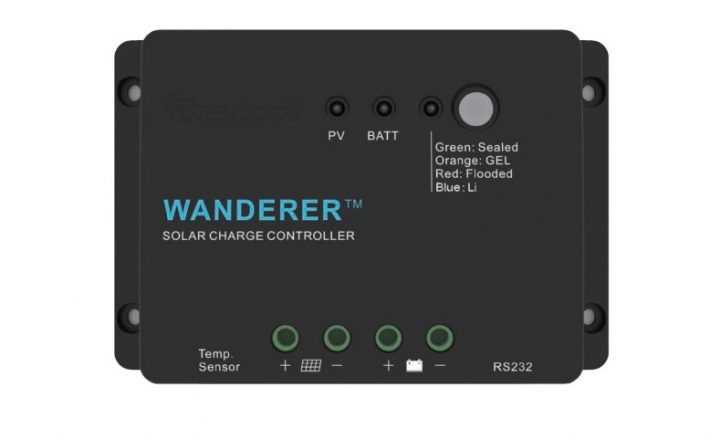This manual contains important safety, installation, and operating instructions for the charge controller. The following symbols are used throughout the manual:
| Warning | Indicates a potentially dangerous condition. Use extreme cautionwhen performing this task |
| Caution | Indicates a critical procedure for safe and proper operation of theController |
| Note | Indicates a procedure or function that is important to the safe andproper operation of the controller |
General Safety Information
- Read all of the instructions and cautions in the manual before beginning the installation.
- There are no serviceable parts for this controller. Do NOT disassemble or attempt to repair the controller.
- Make sure all connections going into and from the controller are tight. There may be sparks when making connections, therefore, make sure there are not flammable materials or gases near installation.
Charge Controller Safety
- NEVER connect the solar panel array to the controller without a battery. The battery must be connected first. This may cause a dangerous occurrence where the controller would experience a high open-circuit voltage at the terminals.
- Ensure input voltage does not exceed 25 VDC to prevent permanent damage. Use the Open Circuit (Voc) to make sure the voltage does not exceed this value when connecting panels together in series.
- The charge controller should be installed indoors in a well-ventilated, cool, and dry environment.
- Do NOT allow water to enter the controller.
Battery Safety
- Do NOT let the positive (+) and negative (-) terminals of the battery touch each other.
- Use only sealed lead-acid, flooded, gel or lithium batteries which must be deep cycle.
- Explosive battery gases may be present while charging. Be certain there is enough ventilation to release the gases.
- Be careful when working with large lead acid batteries. Wear eye protection and have fresh water available in case there is contact with the battery acid.
- Over-charging and excessive gas precipitation may damage the battery plates and activate material shedding on them. Too high of an equalizing charge or too long of one may cause damage. Please carefully review the specific requirements of the battery used in the system.
- Equalization is carried out only for non-sealed / vented / flooded / wet cell lead acid batteries.
- Do NOT equalize VRLA type AGM / GEL / LITHIUM batteries UNLESS permitted by battery manufacturer.
- Default charging parameters in Li mode are programmed for 12.8V Lithium Iron Phosphate (LFP) Battery only. Before using Wanderer to charge other types of lithium battery, set the parameters according to the suggestions from battery manufacturer.
Warning: Connect battery terminals to the charge controller BEFORE connecting the solar panel(s) to the charge controller. NEVER connect solar panels to charge controller until the battery is connected.
General Information
The Wanderer is an advanced charge controller for off-grid solar applications and can be used with a 12V battery or battery bank. Integrating highly efficient PWM charging, the Wanderer increases battery life and improves system performance. The controller comes. equipped with fully omprehensive self-diagnostics and electronic protection functions to prevent damage from installation mistakes or system faults.
Key Features
- Optimized for 12 VDC system voltage
- 30A charging capacity.
- Deep Cycle Sealed, Gel, Flooded, and Lithium battery options.
- 4 Stage PVM charging: Bulk, Boost. Float, and Equalization
- Temperature compensation and correcting the charging and discharging parameters, automatically, improving battery life.
- Protection against: reverse current, overcharging, short-circuit and reverse polarity.
- Negative ground controller
- Multiple LED indicators for easy to read charge status and battery information.
- Remote temperature compensation compatible (accessory sold separately)
- Integrated communication port for remote monitoring.
- Charges over-discharged lithium batteries.
PWM Technology
The Wanderer utilizes Pulse Width Modulation (PWM) technology for battery charging. Battery charging is a current based process so controlling the current will control the battery voltage. For the most accurate return of capacity, and for the prevention of excessive gassing pressure, the battery is required to be controlled by specified voltage regulation set points for Absorption, Float, and Equalization charging stages. The charge controller uses automatic duty cycle conversion, creating pulses of current to charge the battery. The duty cycle is proportional to the difference between the
sensed battery voltage and the specified voltage regulation set point. Once the battery reached the specified voltage range, pulse current charging mode allows the battery to react and allows for an acceptable rate of charge for the battery level. The Wanderer has a 4-stage battery charging algorithm for a rapid, efficient, and safe battery charging. They include: Bulk Charge, Boost Charge, Float Charge, and Equalization.

Bulk Charge: This algorithm is used for day to day charging. It uses 100% of available solar power to recharge the battery and is equivalent to constant current.
Boost Charge: When the battery has charged to the Boost voltage set-point, it undergoes an absorption stage which is equivalent to constant voltage
regulation to prevent heating and excessive gassing in the battery. The Boost time is 120 minutes.
Float Charge: After Boost Charge, the controller will reduce the battery voltage to a float voltage set point. Once the battery is fully charged, there will be no more chemical reactions and all the charge current would turn into heat or gas. Because of this, the charge controller will reduce the voltage charge to smaller quantity, while lightly charging the battery. The purpose for this is to offset the power consumption while maintaining a full battery storage capacity. In the event that a load drawn from the battery exceeds the charge current, the controller will no longer be able to maintain the battery to a Float set point and the controller will end the float charge stage and refer back to bulk charging.
Equalization: This is carried out every 28 days of the month. It is intentional overcharging of the battery for a controlled period of time. Certain types of batteries benefit from periodic equalizing charges, which can stir the electrolyte, balance battery voltage, and complete chemical reaction. Equalizing charge increases the battery voltage, higher than the standard complement voltage, which gasifies the battery electrolyte.
Warning: Once equalization is active in the battery charging, it will not exit this stage unless there is adequate charging current from the solar panel. There should be NO load on the batteries when in equalization charging stage. Over-charging and excessive gas precipitation may damage the battery plates and activate material shedding on them. Too high of equalizing charge or for too long may cause damage. Please carefully review the specific requirements of the battery used in the system.
Warning: Over-charging and excessive gas precipitation may damage the battery plates and activate material shedding on them. Too high of equalizing charge or for too long may cause damage. Please carefully review the specific requirements of the battery used in the system.
Lithium Battery Activation
The Wanderer PVM charge controller has a reactivation feature to awaken a sleeping lithium battery. The protection circuit of lithium battery will typically turn the battery off and make it unusable if over-discharged. This can happen when storing a lithium battery pack in a discharged state for any length of time as self-discharge would gradually deplete the remaining charge. Without the wake-up feature to reactivate and recharge batteries, these batteries would become unserviceable and the packs would be discarded. The Wanderer will apply a small charge current to activate the protection circuit and if a correct cell voltage can be reached, it starts a normal charge.
Optional Components
The Wanderer is shipped with by itself with no additional components. Optional components that require a separate purchase:
Remote Temperature Sensor (TS-R):
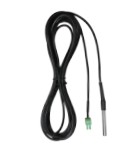
Measures the temperature at the battery and uses this data for very accurate temperature compensation. The sensor is supplied with a 9.8ft cable length that connects to the charge controller.
BT-1 Bluetooth Module:
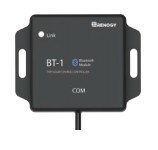
The BT-1 Bluetooth module is a great addition to any Renogy charge controller with a RS232 port and is used to pair charge controllers with the Renogy BT App. After pairing is done you can monitor your system and change parameters directly from you cell phone or tablet. No more wondering how your system is performing, now you can see performance in real time without the need of checking on the controller’s LCD.
Identification of Parts
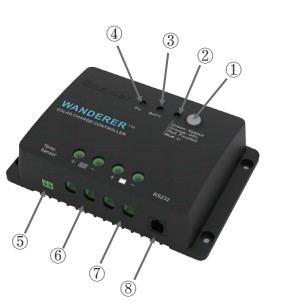
- Battery Select Button
- Battery Type Indicator
- Battery Indicator
- PV Indicator
- Remote Temperature Sensor Port (optional accessory)
- PV Terminals
- Battery Terminals
- RS-232 Port (optional accessory)
Installation
Warning: Connect battery terminal wires to the charge controller FIRST then connect the solar panel(s) to the charge controller. NEVER connect the solar panel to charge controller before the battery.
Caution: Do not over-torque or over tighten the screw terminals. This could potentially break the piece that holds the wire to the charge controller. Refer to the technical specifications for max wire sizes on the controller and for the maximum amperage going through wires.
Mounting Recommendations
Warning: Never install the controller in a sealed enclosure with flooded batteries. Gas can
accumulate and there is a risk of explosion.
- Choose Mounting Location—place the controller on a vertical surface protected from direct sunlight, high temperatures, and water. Make sure there is good ventilation.
- Check for Clearance—verify that there is sufficient room to run wires, as well as clearance above and below the controller for ventilation. The clearance should be at least 6 inches (150mm).
- Mark Holes
- Drill Holes: Note that the Wanderer is not equipped with screws for wall mounting.
- 5. Secure the charge controller.
Battery
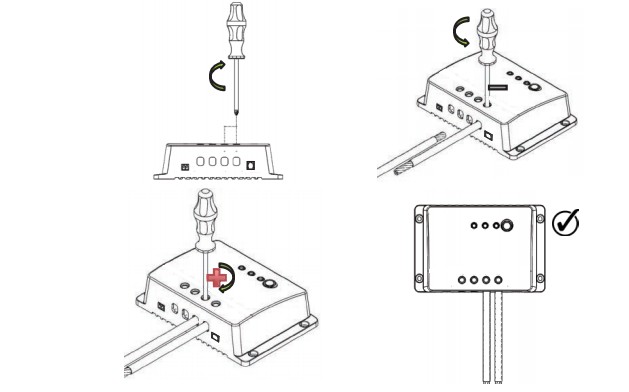
Solar Panel
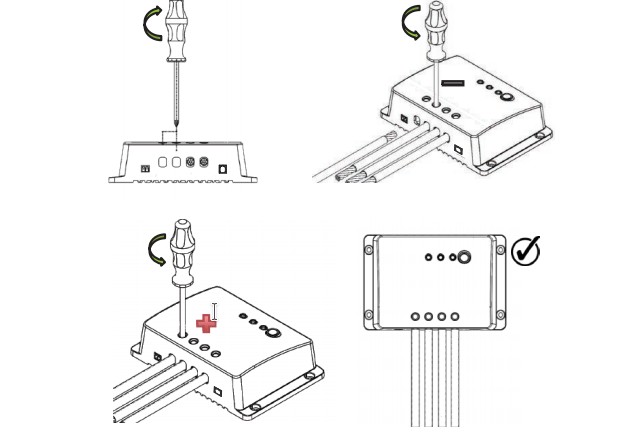
Bluetooth Module Communication (optional)
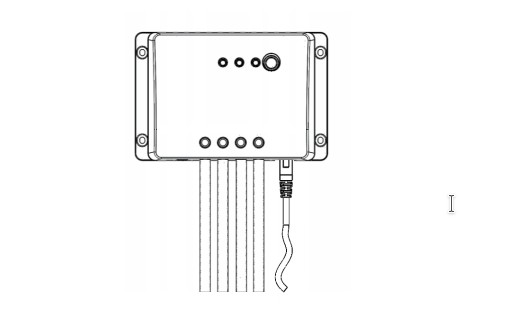
Temperature Sensor (optional, not polarity sensitive)
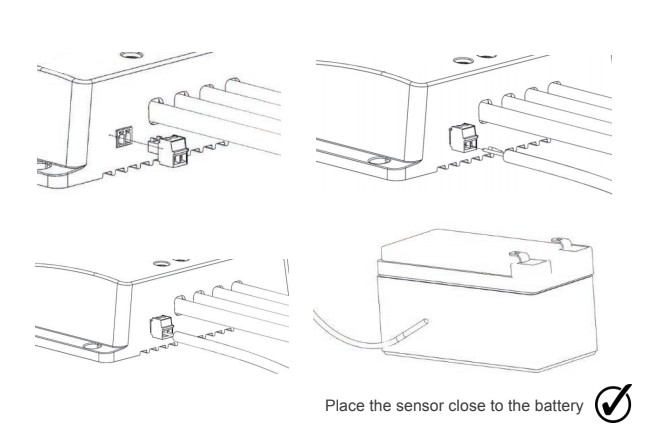
Operation
After connecting the battery to the charge controller, the controller will turn on automatically. The operation of this controller is very simple. Users set the battery type, and leave the rest of the work to the charge controller.
Setting Battery Type
Simply hold the gray button for approximately 7 seconds until the LED flashes. Once flashing, then press the gray button again to the desired battery type (they are color coded) and simply leave the controller alone until the flashing stops (this should take approximately 10 seconds). This indicates the parameter has been set.
Note: If the LED lights do not flash, hold the gray button for 7 seconds again, release, and immediately press the gray button again to enable the flashing.

LED Indicators
The Wanderer is a simple to use controller requiring little to no maintenance. Users can be informed about the charge controller’s status based on the LED indicators at the PV and Battery levels. The following chart goes into further detail regarding the Wanderer’s indicators.
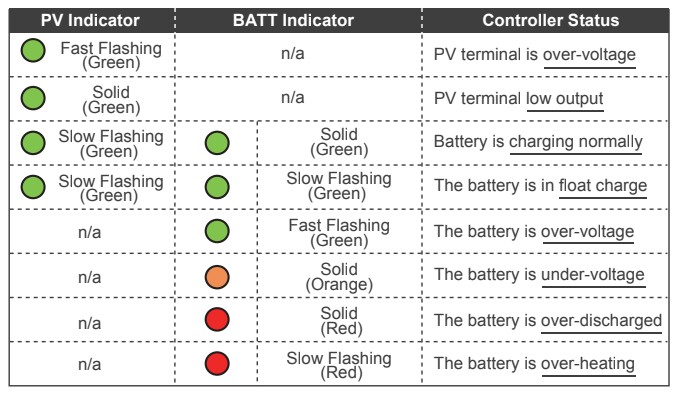
System Status Troubleshooting
| Description | Troubleshoot |
| Battery is low-voltage | Use a multimeter to verify the rated battery voltage. Disconnect any loads connected to the battery to allow it to charge. |
| Battery is over-voltage | Use a multi-meter to check the voltage of the battery. Make sure the battery voltage is not exceeding the rated specification of the charge controller. Disconnect battery. |
| PV is over-voltage | Use a multi-meter to check the voltage of the panels.Ensure that they meet the specification of the controllerto not exceed 25 VDC. |
| PV terminal low output | The PV output is typically lower in the early morningsand in the late afternoons. This should not requiretroubleshooting unless a solar panel is defective. |
| Battery is over-heating | When heat is exceeding the specification of the controller, it will automatically shut down. The controller will resume to operate once it interprets a change in temperature. |
| Other Considerations | |
| Charge controller does not charge during daytime when the sun is shining on the solar panels. | Confirm that there is a tight and correct connection fromthe battery bank to the charge controller and the solarpanels to the charge controller. Use a multi-meter tocheck if the polarity of the solar modules have beenreversed on the charge controller’s solar terminals. |
| No LED indicator whenbattery is connected to the charge controller | The battery voltage may be less than 9V. A minimum of9V is required to power on the controller. |
| Battery LED light doesnot flash when holdingfor 7 seconds. | The battery selection LED must be enabled. Disconnectthe battery from the controller, then connect the battery to the controller to reset it. Then hold the gray button for 7 seconds, release the button, and then immediately press the gray button one more time to select a battery type. |
Maintenance
For best controller performance, it is recommended that these tasks be performed from time to time.
- Check that controller is mounted in a clean, dry, and ventilated area.
- Check wiring going into the charge controller and make sure there is no wire damage or wear.
- Tighten all terminals and inspect any loose, broken, or burnt up connections.
Fusing
NEC Maximum Current for different Copper Wire Sizes
| AWG | 16 | 14 | 12 | 10 | 8 | 6 | 4 | 2 | 0 |
| Max. Current | 18A | 25A | 30A | 40A | 55A | 75A | 95A | 130A | 170A |
Please Note: The NEC Code requires overcurrent protection shall not exceed 15A for 14 AWG, 20A for 12 AWG, and 30A for 10 AWG copper wire.
Fuse from Controller to Battery
Controller to Battery Fuse = Current Rating of Charge Controller Ex. 30A Wanderer = 30A fuse from Controller to Battery
Fuse from Solar Panel(s) to Controller
Ex. 200W; 2 X 100 W panels
Parallel
Total Amperage = Isc1 + Isc2 = (5.75A + 5.75A) * 1.56 Fuse = minimum of 11.5 * 1.56 = 17.94= 18A fuse
Technical Specifications
Electrical Specifications
| Description | Parameter |
| Nominal system voltage | 12 VDC |
| Rated Charge Current | 30A |
| Max. PV Input Voltage | 25 VDC |
| Self-Consumption | ≤ 10mA |
| Temp. Compensation | -3Mv/C/2V |
| Max. Terminal Size | 10mm 8 AWG |
| Working Temperature | -35 C to +45 C/-20 F to 113 F |
| Net Weight | 0.29kg 0.65lb |
| Dimensions | 163.8×109.6×44.7mm 6.5×4.3×1.8in |
| Enclosure | IP20 |
| Communication | RS232 |
| Certification | CE, RoHS,FCC Part 15 Class B, RCM |
This equipment has been tested and found to comply with the limits for a class B digital device, pursuant to part 15 of the FCC Rules. These limits are designed to provide reasonable protection against harmful interference in a residential installation. This equipment generates, uses and can radiate radio frequency energy and if not installed and used in accordance with the instructions, may cause harmful interference to radio communications. However, there is no guarantee that interference will not occur in a particular installation. If this equipment does cause harmful interference to radio or television reception, which can be determined by turning the equipment off and on, the user is encouraged to try to correct the interference by one or more of the following measures:
- Reorient or relocate the receiving antenna.
- Increase the separation between the equipment and receiver.
- Connect the equipment into an outlet on a circuit different from that to which the receiver is connected.
- Consult the dealer or an experienced radio/TV technician for help.
This device complies with Part 15 of the FCC Rules. Operation is subject to the following two conditions: (1) this device may not cause harmful interference, and (2) this device must accept any interference received, including interference that may cause undesired operation.
Battery Charging Parameters
| Battery Type | SEALED/AGM | GEL | FLOODED | LI(LFP) |
| Over-voltage Warning | 16V | 16V | 16V | 16V |
| Charging Limit Voltage | 15.5V | 15.5V | 15.5V | 15.5V |
| Over-voltage Recover | 15V | 15V | 15V | 15V |
| Boost Charge Voltage | 14.6V | 14.2V | 14.6V | 14.2V(User 12.6-16v) |
| Float Charge Voltage | 13.8V | 13.8V | 13.8V | – |
| Equalization Voltage | – | – | 14.8V | – |
| Boost Return Voltage | 13.2V | 13.2V | 13.2V | 13.2V |
| Under Voltage Warning | 12V | 12V | 12V | 12.1V |
| Under Voltage Recover | 12.2V | 12.2V | 12.2V | 12.3V |
| Over-discharge Warning | 11.1V | 11.1V | 11.1V | 11.1V |
| Over-discharge Recover | 12.6V | 12.6V | 12.6V | 12.6V |
| Boost Duration | 2 hours | 2 hours | 2 hours | —- |
| Equalization Interval | —- | —- | 28 days | —- |
| Equalization Duration | —- | —- | 28 days | —- |
*Battery charging parameters in LI mode can be programmed using Renogy BT App.
** Default charging parameters in LI mode are programmed for 12.8V LFP battery. Before using Wanderer to charge other types of lithium battery, set the parameters according to the suggestions from battery manufacturer.
Dimensions
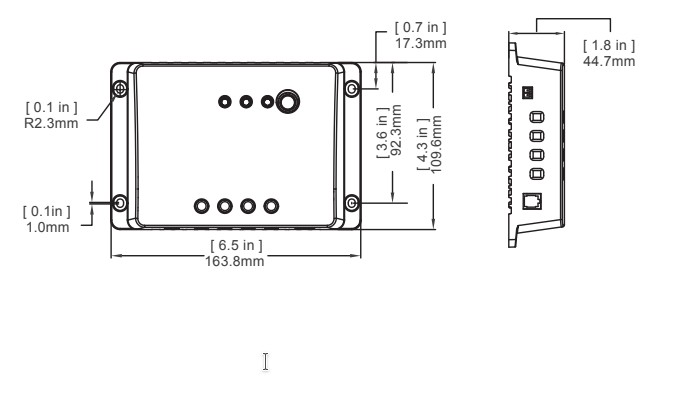
You can download the PDF version of the Renogy Wanderer Solar Charge Controller manual here.
